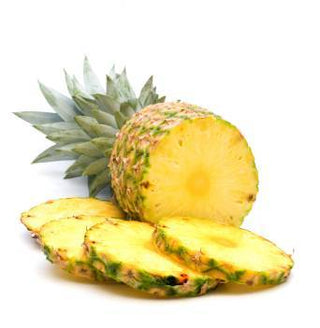(Ananas comosus)
Pineapple, which is described s both sweet and tart, is second only to banana as the favorite tropical fruit of the United States. Each of the flowers on a blossoming pineapple plant forms an individual fruit that fuses together around a central core. Each fruitlet forms an “eye” that is apparent on the skin’s surface. Pineapples are cylindrical in shape with scaly green, brown or yellow skin with mature fruits weighing 2 to 6 pounds. After the fruit is produced, the main stem forms waxy blue green leaves at the crown of the pineapple.
While pineapples are indigenous to South America, Spanish and Portuguese explorers introduced the tropical fruit to their Asian, African, and South Pacific colonies. Today, pineapples still serve as an important export in many of these regions.
The Northern Hemisphere leads fresh pineapple production, notably Puerto Rico, Brazil, Mexico, the Caribbean, and Hawaii. Today, only two companies grow pineapples in Hawaii. Maui Pineapple Company markets their Maui Gold brand and Dole Pineapple markets its Hawaii Gold brand.
A few of the most well known varieties of pineapple include the Red Spanish and Smooth Cayenne. The Smooth Cayenne, a variety from Hawaii, is tall and cylindrical that has a golden-yellow color and is high in both sugar and acid. The Red Spanish, usually from Florida or Puerto Rico, is shorter and plumper with reddish gold skin.
Nutrition Facts
A cup of fresh-chunked pineapple has only 82 calories, 2 grams of fiber and a gram of protein. Although a serving of pineapple contains 16 grams of sugar, the fiber results in the slow release of the sugar into the blood stream, giving pineapples a low score on the glycemic index.
Pineapple is an excellent source of vitamin C. One serving provides 78.9 mg, or 131% of the Daily Values. This tropical fruit is also an excellent source of the trace mineral manganese with one serving providing 1.5mg or 76% of Daily Values.
If you cannot find fresh pineapple, or prefer to enjoy your pineapple canned, preserve the health benefits by choosing fruit packed in juice or water instead of high sugar, high calorie syrup.
Health Benefits
Pineapple contains bromelain, a protein-digesting enzyme similar to papain from papaya, actinidin from the kiwifruit and ficin from the fig. Bromelain is extracted from the stem and fruit of the pineapple and is often sold as a supplement to enhance digestion. Taken at a therapeutic dose, numerous studies have demonstrated that bromelain exhibits significant anti-inflammatory effects. Use of bromelain can result in significant reduction in pain and edema, as well as enhanced circulation to the injured site. For this reason, bromelain containing supplements are often used following surgery, injury, trauma especially to soft tissue.
Selection and Storage
Pineapples can be found year round but are at their best from March through June.
When making your pineapple selection, be sure to choose a fruit that is heavy with crisp, dark green leaves. Pineapples stop ripening as soon as they are picked. To ensure you choose a pineapple at its peak, select a fruit that is sweet smelling at the stem end. Pineapples that give off a sour or fermented smell, or those with soft spots and bruising, should be avoided.
When you bring your succulent treat home, store it in the refrigerator tightly wrapped in plastic. Stored in this way, pineapples can remain fresh for about 3-5 days. Pineapples can also be kept at room temperature for about 2 days. The pineapple will not ripen further if stored at room temperature, but it will become softer and juicier. Once cut, pineapple can be stored in an airtight container in the refrigerator for about 3 days. Your pineapple will remain freshest if you fill the container with a bit of liquid – preferably pineapple juice.
No matter how you choose to cut your pineapple, begin by slicing off the base and leaves with a sharp knife. From here, an easy next step is to stand your pineapple on one end and shave off strips of skin. After the skin is removed any remaining eyes can be carved out with a small knife. To remove the core, cut your pineapple into quarters and slice off the core. A pineapple corer, a gadget available at kitchen supply stores, is not recommended because too much of the fruit gets wasted.
Recipes
Like so many other fruits, the best way to eat pineapple is fresh. You can add fresh chunks to a fruit salad, or serve with salad greens and combine with chicken or shrimp, avocado, cilantro and lime to create a tropical dish. As a dessert, serve pineapple chunks with walnuts.
Because pineapple contains the protein digesting enzyme bromelain, pineapple juice makes an excellent marinade and tenderizer for meat. For this reason, pineapple must be pre-cooked if incorporated in recipes that include gelatin.
Pineapple serves as a zesty and delicious side or chutney served with your favorite type of protein. Just dice pineapple, mango, red bell pepper, kiwifruit and put in bowl. Add chopped cilantro, red pepper, black pepper and rice vinegar. This chutney makes an exceptional complement to grilled salmon or halibut.
For another delightful take on the pineapple/seafood combination, check out Maple Glazed Salmon with Pineapple.
For a recipe more of a side dish than a salsa, try Grilled Pineapple and Avocado Salad – as refreshing as it is colorful!
If you are looking for something sweet and creamy without all the calories of a dish of pineapple ice cream, try an Orange Pineapple Smoothie. Note, if you prefer not to use artificial sweeteners, honey will add the perfect hint of sweetness to this icy treat. Another option is to skip the sweetener all together; it is not necessary with something as succulent as pineapple in the mix!
Fun Facts
In order for pineapples to remain seedless, the plants need to be cross-pollinated by hand. In Hawaii, where pineapples are cultivated for agriculture, importation of hummingbirds is prohibited for this reason.

